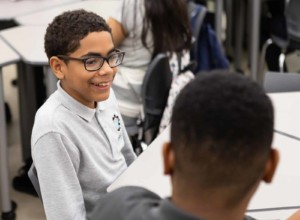Why Youth Need Social Capital and How Schools Can Help

It’s all about who you know. Social capital often determines where a young person goes to school, the work experiences they gain, what jobs are available, and how quickly careers advance.
For two decades, education reform has been so preoccupied with model enhancements toward academic improvements that social capital has been neglected as a key outcome of youth development. In the meantime, social connections have become more important than ever but less available to students growing up in mobile low-income families.
In her new book, Who You Know, Julia Freeland Fisher makes the case that the “structures, tools, and institutional designs that could start to double down on relationships inside of school and take the chance out of students’ chance encounters beyond school.”
Fisher is the director of education research at the Clayton Christensen Institute. Her education was the product of social capital starting with The College Preparatory School, an academically intense school where Fisher benefited from a circle of adults that pushed and supported her.
A summer study program in Honduras laid bare the vast inequalities in the social capital lottery for Fisher. It inspired her Latin Studies at Princeton University.
After college, a policy and advocacy fellowship at NewSchools Venture Fund inspired her to attend Yale Law School.
Leaning more to innovation than precedent and having concluded that she wanted to write and have an impact, Fisher went to work at the Christensen Institute to advance productive disruption in education.
Why Social Capital?
After a couple years of writing about blended learning, Fisher has this nagging feeling that the achievement gap was only half of the story.
She learned that over half of all job placements result from a personal connection—and that schools just aren’t set up to influence this critical success factor. Schools may be social, but most are insular.
Fisher also observed that an enrichment gap compounds the achievement gap. And, that with a rich array of travel and experiences often comes with a rich set of connections that yield long-term benefits.
Applying the innovation lens to the problem, Fisher saw an ed tech market flooded with content and assessment but infrequent uses of tech to connect learners to mentors, experts, and peers.
Innovation for Social Capital
Fisher sees potential in three types of innovations:
- Fully virtual: apps like Nepris bring virtual mentors into a classroom. (She’s a little nervous about simulated relationships in virtual reality)
- Online connecting offline: apps like ImBlaze from Big Picture Learning are like Uber for social capital lifting logistical barriers and connecting youth to work-based learning.
- Integrated student supports: wrap around youth and family services to lift barriers. The best ones keep teachers in the loop.
On fighting the tyranny of time, Fisher sees potential in more extended learning opportunities through programs like LRNG and granting credit for out of school learning.
She thinks high schools could open up more slots for learning, not just courses but internships. Fisher points to schools like Del Lago Academy where business partners provide work experiences and define badges.
Fisher also thinks a good advisory system can also help develop social and emotional skills and make external connections.
The full title—Who You Know: Unlocking Innovations That Expand Students’ Networks—reveals her interest in broad-based solutions to this big gap.
Here’s a suggestion: buy a few copies for your local high school administrators, chamber of commerce, and mayor and host a conversation about how kids in your community can build more social capital.
Key Takeaways:
[:19] About today’s topic and guest.
[1:19] Tom welcomes Julia to the podcast.
[1:40] About Julia’s early education.
[3:49] Where Julia’s interest in Latin studies came from.
[5:07] Why Julia went to law school.
[6:12] Where Julia’s interest in education came from.
[7:55] What led Julia to the Clayton Christensen Institute.
[9:07] Julia gives a brief explanation on what disruptive innovation is.
[10:32] How did the leading voice for personalized and blended learning decide to study social capital?
[13:03] What Tom was surprised to learn from Julia’s book, Who You Know.
[14:54] Tom reads a quote from Who You Know that sums up the equity issue and Julia explains it more thoroughly.
[16:02] Innovations Julia has seen that have helped to expand students’ networks.
[18:02] Julia’s thoughts on virtual mentoring networks.
[20:10] About the iNACOL Book Party with Lydia, Tom, and Julia.
[20:35] Does Julia think virtual reality is going to play a role in introducing young people to career opportunities?
[21:56] Julia explains online connecting offline.
[23:10] Julia explains integrated student services.
[25:19] How do we make social capital more important? How do we create time in busy, secondary schedules for things like mentorships and work-based learning?
[27:26] Julia describes key differences between a traditional high school and one that is aiming toward building social capital.
[33:54] About Julia’s experience co-authoring with her husband.
[35:19] How, when and where did Julia write?
[36:15] What is Julia’s next book on?
[37:29] What has been humbling for Julia while she has been giving talks on the book?
Mentioned in This Episode:
Julia Freeland Fisher’s LinkedIn
Clayton Christensen Institute
Disrupting Class: How Disruptive Innovation Will Change the Way the World Learns, by Clayton Christensen, Curtis W. Johnson, and Michael B. Horn
Who You Know: Unlocking Innovations That Expand Students’ Networks, by Julia Freeland Fisher and Daniel Fisher
Better Together: How to Leverage School Networks For Smarter Personalized and Project Based Learning, by Tom Vander Ark and Lydia Dobyns
NewSchools Venture Fund
Community Share
ImBlaze
LRNG.org
Del Lago Academy
One Stone
WhoYouKnow.org
For more see
- Powerful Learning Experiences: Why All Students Deserve Access
- The Role of Advisory in Personalizing the Secondary Experience
Stay in-the-know with all things edtech and innovations in learning by signing up to receive the weekly Smart Update. This post includes mentions of a Getting Smart partner. For a full list of partners, affiliate organizations and all other disclosures, please see our Partner page.








0 Comments
Leave a Comment
Your email address will not be published. All fields are required.